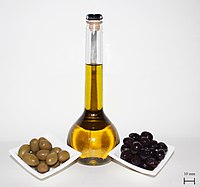
Photo from wikipedia
In this study, a novel peptide was isolated from the black soybean byproduct using bioactive guided isolation technique. Initially, the hydrolysate of black soybean protein was fractionated and separated sequentially… Click to show full abstract
In this study, a novel peptide was isolated from the black soybean byproduct using bioactive guided isolation technique. Initially, the hydrolysate of black soybean protein was fractionated and separated sequentially by ultrafiltration, Sephadex G 25 chromatography and reverse-phase HPLC techniques. The peptide fractions that collected in each step were tested for their antioxidant capacity and anticancer activities against human liver (HepG2), lung (MCF-7) and cervical (Hela) cancer cell lines. The most active fraction was subjected to further purification. The final purified peptide fraction (F2-c) with the molecular weight of 455.0 Da showed highest DPPH free radical scavenging and hydroxyl radical scavenging activity with the IC50 values of 0.12 and 0.037 µM, respectively. Moreover, it showed high cytotoxic potential against HepG2, MCF-7 and Hela cells with the IC50 values of 0.22, 0.15 and 0.32 µM, respectively. The amino acid sequence of F2-c was identified as Leu/Ile-Val-Pro-Lys (L/I-VPK). Molecular docking studies revealed that the purified peptides effectively bound with four apoptosis related key proteins (XIAP, caspase-3, caspase-7, and Bcl-2) via hydrophobic effects and hydrogen bonds, amongst them, the peptide-caspase-3 binding showed the strongest binding energy. All the results suggested that the peptide fraction Leu/Ile-Val-Pro-Lys from black soybean byproduct with significant antioxidant and anticancer activities could be a good candidate for functional foods or related drugs.Graphical abstract
Journal Title: European Food Research and Technology
Year Published: 2018
Link to full text (if available)
Share on Social Media: Sign Up to like & get
recommendations!